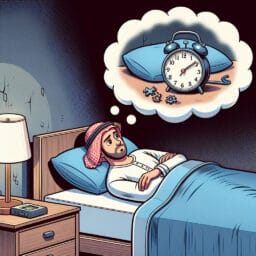
Unlocking Restful Sleep: Cognitive-Behavioral Strategies for Insomnia Sufferers
Table of Contents
- Introduction
- Understanding Insomnia
- Cognitive-Behavioral Therapy for Insomnia (CBT-I)
- Implementing CBT-I Strategies at Home
- Overcoming Challenges and Setbacks
- When to Seek Professional Help
- Conclusion
- Frequently Asked Questions
Introduction
The pervasive challenge of chronic insomnia has far-reaching consequences on one’s mental health and daily functioning, with individuals tirelessly searching for efficacious treatments beyond the usual sleep medications. Cognitive Behavioral Therapy for Insomnia (CBT-I) stands as a beacon of hope, heralded by clinical practice guidelines as the first-line treatment for this relentless disorder. This systematic approach delves into the intricacies of a person’s sleep problems, aiming to realign the body’s natural sleep mechanism through targeted behavioral interventions. Unlike sleeping pills which offer short-term respite, CBT-I equips patients with lifelong skills to combat unhelpful thoughts and habits that hinder restful slumber.
At its core, CBT-I effective strategies revolve around devising a personalized sleep schedule that promotes falling asleep faster and staying asleep longer—addressing issues such as lying awake fraught with insomnia thoughts. It includes relaxation training that teaches individuals how to disengage from stressors and unwind before bedtime. Through relaxation techniques, those suffering can tap into their inherent ability to transition smoothly into sleep—a primary goal in treating insomnia without reliance on sleep medications.
Moreover, part of CBT-I’s efficacy lies in its capacity to dismantle poor sleep hygiene practices by fostering an environment conducive to restful sleep. Patients learn critical skills like managing environmental factors that impact their ability to stay asleep throughout the night. These behavioral interventions are considered effective not only for chronic insomnia disorder but even those grappling with situational or short-term insomnia.
Engaging in cognitive restructuring within CBT-I allows individuals to identify and alter detrimental beliefs about sleep—such as catastrophic thinking patterns when they can’t fall asleep immediately—which perpetuates anxiety and wakefulness at night. The power of transforming these attitudes is instrumental in re-establishing confidence in one’s own capability to achieve restorative shut-eye naturally.
In essence, while chronic insomnia might seem an insurmountable adversary, embracing cognitive-behavioral therapy offers a structured yet flexible arsenal against it—ushering patients towards sustainable mental health wellness through mastering their nocturnal rhythms without leaning on medicinal crutches.
Understanding Insomnia
For those entangled in the nightly struggle of chronic insomnia, Cognitive Behavioral Therapy for Insomnia (CBT-I) represents a dawn of relief, accredited by clinical practice guidelines as the first-line treatment to recalibrate the body’s natural sleep mechanism. The effectiveness of CBT-I lies in its strategic blend of behavioral interventions and relaxation techniques that directly address both the psychological and physiological facets of sleep disorders. By systematically reviewing an individual’s sleep patterns and identifying personal triggers for poor sleep, CBT-I enables patients to devise strategies that foster healthier sleeping habits – a cornerstone for treating insomnia without depending on sleep medication.
An expert viewpoint often highlights that one significant misstep contributing to chronic insomnia disorder is our modern lifestyle’s interference with our circadian rhythms. This disruption can be addressed by adhering to a consistent sleep schedule—tailored during CBT-I sessions—which paves the way for falling asleep more effortlessly and staying asleep longer. Such regimented routines become pivotal in anchoring one’s biological clock, promoting restful sleep night after night.
In tackling cognitive distortions—the unhelpful thoughts that frequently plague insomniacs as they lie awake—it’s essential to recognize how these mental patterns exacerbate anxiety around bedtime and impede our ability to stay asleep. Through practiced relaxation training within CBT-I therapy, individuals learn how not only to quieten their mind but also engage their body into states conducive for slumber, effectively countering short-term insomnia and alleviating long-standing nighttime strife.
Let’s demystify this: while sleeping pills may offer a temporary escape from wakefulness, they do not address the underlying issues causing sleep problems; hence their role should remain supplementary rather than primary goal-oriented solutions. In stark contrast stands CBT-I—its effective techniques rooted deeply in evidence-based research offer concrete hope beyond mere symptomatic relief provided by conventional sleep medicine.
Bearing mental health at its core, implementing these therapeutic strategies positively impacts overall well-being—a systematic review confirms that when individuals with both acute and chronic forms embrace these practices consistently, there is a notable improvement not only in their quality of nocturnal rest but also in daytime functioning.
In summing up this dialogue on combating chronic insomnia through cognitive-behavioral therapy—one truth resonates clear: engaging with CBT-I transcends merely learning how to fall into peaceful slumber; it is fundamentally reclaiming command over one’s life from dusk till dawn.
Cognitive-Behavioral Therapy for Insomnia (CBT-I)
When grappling with the pervasive issue of chronic insomnia, Cognitive Behavioral Therapy for Insomnia (CBT-I) shines as a beacon of hope, esteemed by experts and backed by systematic reviews as a superior first-line treatment. This sophisticated approach rests on the pillars of behavioral interventions and cognitive therapy, meticulously designed to recalibrate the body’s natural sleep mechanism without dependency on sleep medications. At its heart lies stimulus control therapy—a method to break the bed-sleep disconnect—ensuring that falling asleep becomes an automatic response upon hitting the pillow. Sleep restriction techniques further enhance this process by limiting time in bed to only when drowsy, thereby increasing sleep efficiency and significantly reducing periods where one might lie awake consumed by insomnia thoughts.
The importance of sleep hygiene cannot be overlooked within CBT-I; this encompasses establishing a regular sleep schedule that anchors one’s circadian rhythms to promote staying asleep throughout the night. But it’s not just about what you do at bedtime—factors like caffeine intake, screen time before sleep, and even bedroom environment play crucial roles in cultivating restful slumber conducive mental health wellness. Moreover, relaxation training employed during CBT-I sessions empowers individuals with practical tools like progressive muscle relaxation or breathing exercises to dismantle stress-related barriers preventing them from slipping into deep repose.
Diving deeper into CBT-I’s repertoire reveals cognitive therapy aimed at dispelling unhelpful thoughts that contribute to poor sleep quality. By systematically challenging such distortions through evidence-based strategies, patients reframe their perceptions about sleeping pills’ efficacy versus more sustainable practices for treating insomnia. The crux is reshaping beliefs and attitudes towards slumber—an endeavor that translates into long-term positive outcomes far beyond mere symptom management offered by traditional sleep medicine.
Clinical practice guidelines sing praises for CBT-I effective methodologies in managing chronic insomnia disorder sustainably—with empirical studies indicating significant improvements not only in patients’ ability to stay asleep but also their daytime function and overall quality of life post-treatment. The appeal of foregoing sleeping medication in favor of mastering relaxation techniques provides an additional layer of empowerment for those seeking enduring solutions.
For many individuals yearning for tranquility amid nighttime turmoil, embracing these varied facets—ranging from rigid behavioral modifications like sticking diligently to a tailored bedtime routine all the way through navigating psychological labyrinths—is akin to piecing together a complex jigsaw puzzle where each component is vital in revealing a complete picture: mastery over one’s own patterns leading towards respite-filled nights ahead.
Thusly armed with knowledge about effective strategies within Cognitive Behavioral Therapy for Insomnia (CBT-I), anyone battling relentless wakefulness can envision tangible paths toward reclaiming peaceful evenings—paths which are lit brightly under clinical spotlights advocating transformative behavioral change over transient chemical aids.
| Component | Description | Benefits |
|---|---|---|
| Stimulus Control Therapy | A method to break the bed-sleep disconnect, ensuring falling asleep becomes automatic upon going to bed. | Improves the association between bed and sleep, reduces sleep onset latency. |
| Sleep Restriction Techniques | Limits time in bed to only when drowsy, increasing sleep efficiency and reducing wakeful periods. | Enhances sleep quality, reduces the time spent awake in bed. |
| Sleep Hygiene | Establishing a regular sleep schedule and managing lifestyle factors like caffeine intake and screen time. | Promotes consistent sleep patterns, improves circadian rhythms. |
| Relaxation Training | Teaches practical tools like progressive muscle relaxation and breathing exercises to reduce stress. | Helps to lower barriers to sleep caused by stress and anxiety. |
| Cognitive Therapy | Addresses unhelpful thoughts and perceptions about sleep to reframe attitudes towards sleeping habits. | Reduces cognitive distortions related to sleep, promotes sustainable sleep practices. |
| Clinical Practice Guidelines | Empirical studies support CBT-I methodologies in managing chronic insomnia disorder sustainably. | Significant improvements in sleep, daytime function, and overall quality of life post-treatment. |
| Behavioral Modifications | Includes adherence to a tailored bedtime routine and other behavioral changes. | Empowers individuals with control over their sleep, leading to long-term positive outcomes. |
Implementing CBT-I Strategies at Home
Amidst the complexities of chronic insomnia, a beacon of hope illuminates in the form of Cognitive Behavioral Therapy for Insomnia (CBT-I), a methodical approach endorsed by clinical practice guidelines as the first-line treatment. CBT-I effective strategies offer solace to those caught in an exhausting cycle of sleep disturbances by targeting behavioral interventions and prescribing relaxation techniques that turn restless nights into periods of restful sleep. This evidence-based therapy aims to calibrate one’s internal clock—bolstering the body’s natural sleep mechanism—without resorting to dependency on sleep medications.
One strategic pillar within CBT-I’s arsenal is devising strategies that create a conducive pre-sleep environment, promoting cues that signal it’s time for slumber. Establishing such an atmosphere involves rituals like dimming lights and minimizing noise pollution, which gently nudge the mind towards a state primed for falling asleep. Similarly, sculpting a consistent sleep schedule not only anchors one’s circadian rhythm but also strengthens the association between bed and staying asleep—a routine paramount for those battling poor sleep night after night.
Managing intrusive insomnia thoughts requires skillful navigation of our mental landscape—an endeavor where relaxation training shines as an integral component of treating insomnia without leaning on sleeping pills. Through methods such as guided meditation or deep-breathing exercises, individuals learn how to construct mental buffers against waves of worries that threaten peaceful respite. Such practices serve not just as fleeting relief but cultivate resilience against short-term insomnia triggers and chronic insomnia disorder alike.
Lifestyle changes are equally vital in supporting our intrinsic nocturnal rhythms; these include prudent dietary choices (avoidance of caffeine close to bedtime) and physical activity patterns aligned with energy expenditure during daylight hours—lifestyle alterations lauded within systematic reviews for their efficacy in promoting better slumber quality. By curating habits attuned with healthy resting cycles, people can gradually reconfigure their body chemistry away from reliance on artificial sedation provided by conventional sleep medicine toward more naturalistic means.
Expert viewpoints suggest that combining these myriad elements—each considered effective when implemented diligently—is akin to orchestrating harmonious symphonies where every note contributes toward achieving tranquility through restorative slumber. These varied behavioral interventions pave the way forward: crafting personalized blueprints wherein each individual becomes their own architect designing reprieve-filled evenings leading onto brighter mornings—a primary goal envisaged in every therapeutic outline centered around treating chronic insomnia disorders using CBT-I methodologies.
Overcoming Challenges and Setbacks
For many, the quest for a peaceful night’s slumber is marred by the frustrating cycle of chronic insomnia—a condition where both falling asleep and staying asleep seem like insurmountable challenges. Cognitive Behavioral Therapy for Insomnia (CBT-I) emerges as a beacon of hope, lauded in systematic reviews and clinical practice guidelines as an indispensable first-line treatment. This therapeutic approach transcends conventional sleep medicine by recalibrating the body’s natural sleep mechanism through behavioral interventions rather than reliance on sleep medications.
Embracing CBT-I techniques means engaging with methods such as relaxation training and thought pattern restructuring to tackle unhelpful thoughts that often lie at the root of poor sleep. Expert viewpoints emphasize that consistent application of these strategies, even when progress appears elusive, can significantly diminish prolonged sleep onset times and frequent nocturnal awakenings—cornerstones to achieving restful sleep. Moreover, devising a tailored sleep schedule underpins one’s commitment to treating insomnia; it involves disciplined bedtime routines which serve not just as nightly rituals but also reinforcers of healthy circadian rhythms.
The primary goal within this framework is not only to reduce dependency on sleeping pills but also to cultivate resilience against short-term insomnia flare-ups. For those who lie awake besieged by insomnia thoughts, CBT-I effective approaches offer invaluable tools—for instance, employing relaxation techniques such as progressive muscle relaxation or guided imagery can provide immediate solace while bolstering long-term mental health.
A striking observation gleaned from research points out that individuals adherent to CBT-I protocols often reclaim control over their nights: they learn how to stay asleep despite disruptions and awaken feeling rejuvenated—a testament to the potency of behavioral modification in addressing sleep problems. Ultimately, maintaining consistency with these evidence-based practices fares superiorly compared with intermittent use; it’s about building a sustainable routine where every step forward consolidates gains made towards vanquishing chronic insomnia disorder once and for all—an endeavor well worth embarking upon for anyone yearning for tranquil nights ahead.
When to Seek Professional Help
With chronic insomnia plaguing a significant portion of the population, cognitive behavioral therapy (CBT-I) has emerged as a first-line treatment, distinguishing itself within sleep medicine circles for its non-pharmacological approach. Systematic reviews endorse CBT-I’s efficacy in treating insomnia by employing relaxation techniques and behavioral interventions designed to reinforce the body’s natural sleep mechanism—allowing individuals to fall asleep faster and maintain restful sleep throughout the night. Rather than relying on sleeping pills, which can offer only transient relief, CBT-I focuses on uprooting unhelpful thoughts that often exacerbate poor sleep. By adhering to a structured sleep schedule and utilizing strategies such as relaxation training, patients can combat both chronic insomnia disorder and short-term insomnia with equal deftness. The primary goal of CBT-I is not just to enable patients to stay asleep but also to empower them with lifelong skills that promote overall mental health wellness—a holistic approach considered effective across clinical practice guidelines. For those lying awake besieged by rampant insomnia thoughts, devising personalized strategies through guided CBT-I could be transformative in achieving long-desired tranquility at dusk.
Conclusion
Unlocking restful sleep, Cognitive Behavioral Therapy for Insomnia (CBT-I) is upheld by clinical practice guidelines as a premier first-line treatment for chronic insomnia. By focusing on behavioral interventions and relaxation techniques, CBT-I enables individuals to overcome sleep problems without dependence on sleep medication. Through strategies such as refining a consistent sleep schedule and mastering relaxation training, patients address the root causes of poor sleep—transforming unhelpful thoughts that keep them lying awake into constructive pathways toward mental health wellness. Systematic reviews affirm its effectiveness, revealing how those who adopt CBT-I not only stay asleep but redefine their relationship with rest, evoking harmony within the body’s natural sleep mechanism.



